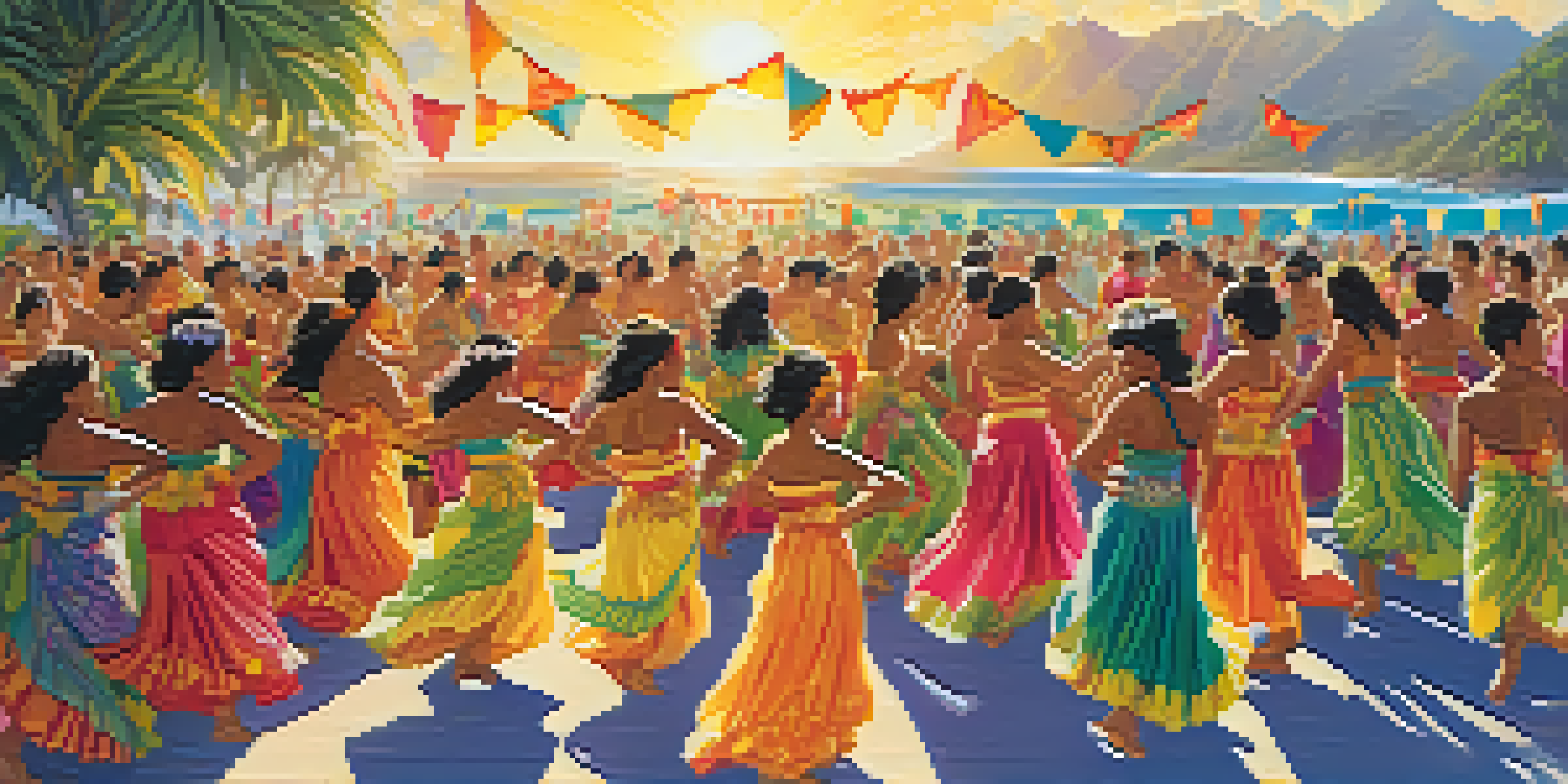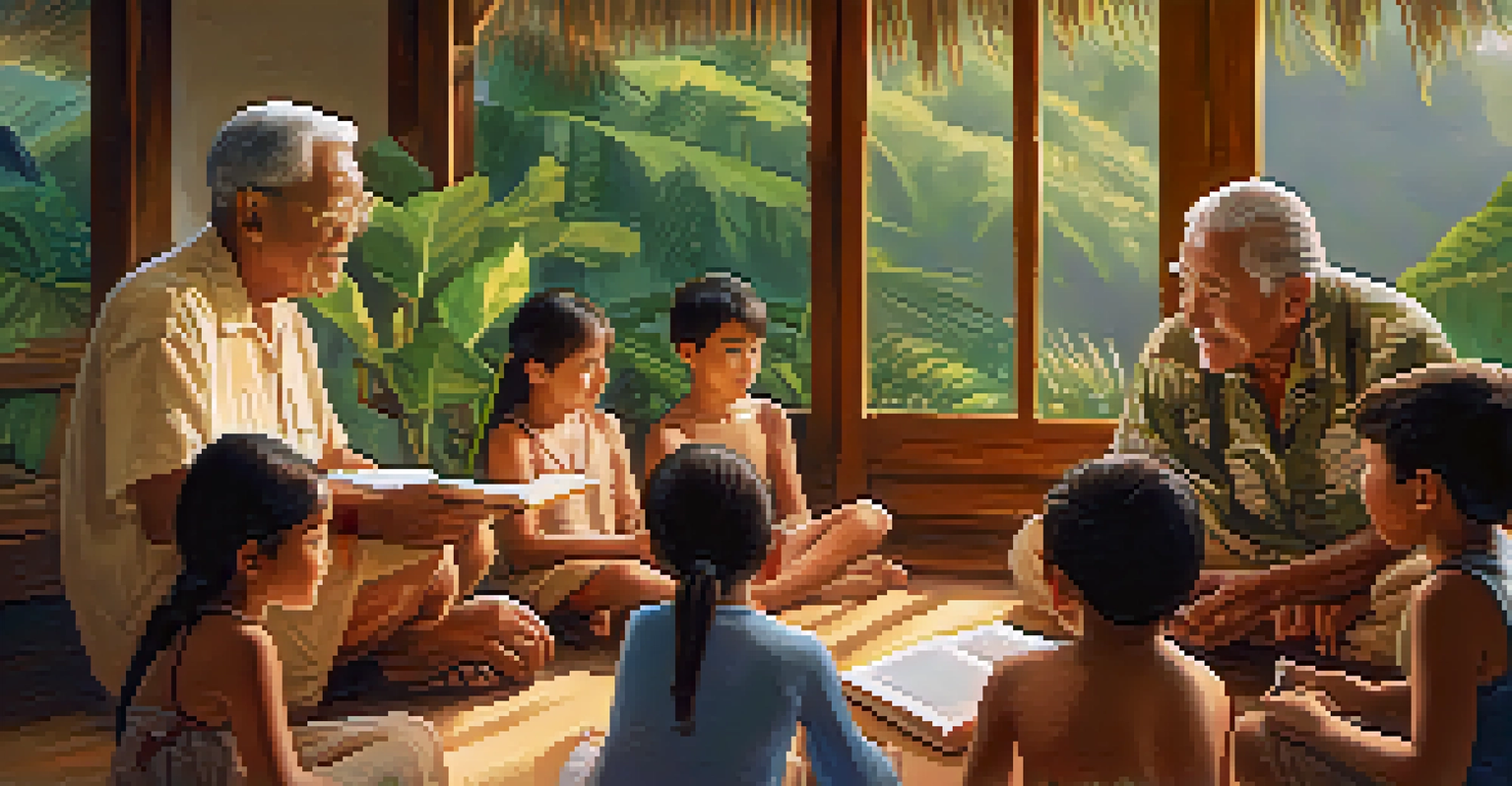The Importance of Language in Preserving Hawaiian Culture

Language as a Cultural Cornerstone in Hawaii
Language is more than just a means of communication; it is the lifeblood of culture. For Hawaiians, the Hawaiian language, or ʻŌlelo Hawaiʻi, carries centuries of tradition, history, and identity. It encapsulates unique perspectives and values that define the Hawaiian way of life.
Language is the road map of a culture. It tells you where its people come from and where they are going.
When we think about culture, we often think about food, dance, and art. However, language is the thread that ties these elements together. It tells stories, conveys ancestral wisdom, and fosters a sense of belonging among the Hawaiian people.
The revitalization of ʻŌlelo Hawaiʻi over recent decades has been crucial in preserving these cultural narratives. As more people learn the language, they also gain insight into the rich tapestry that is Hawaiian culture.
Revitalization Efforts and Their Impact on Communities
In recent years, there has been a significant movement to revitalize ʻŌlelo Hawaiʻi, especially through educational programs. Schools across Hawaii are incorporating Hawaiian language immersion education, allowing children to learn in their native tongue. This initiative not only strengthens language skills but also deepens cultural understanding.

Community classes and cultural workshops are also playing a vital role in this revitalization. They provide a space for people of all ages to connect with their heritage, learn traditional practices, and engage in conversations that honor their ancestors.
Language Revitalization Efforts
Educational programs and community classes are crucial in revitalizing ʻŌlelo Hawaiʻi and fostering cultural pride among Hawaiian communities.
These efforts create a sense of pride and ownership within Hawaiian communities. As more individuals embrace their language, they also contribute to the preservation and continuity of their culture.
Language as a Vehicle for Cultural Expression
Language is a powerful vehicle for cultural expression. In Hawaiian culture, chants (mele) and oral traditions are woven with the nuances of the language, making them rich and meaningful. These forms of expression carry stories of creation, historical events, and familial ties that would be lost without the language.
To have another language is to possess a second soul.
When people engage with the Hawaiian language, they are not just learning vocabulary; they are experiencing the culture itself. Music, poetry, and storytelling become more profound when expressed in their original language, allowing for a deeper emotional connection.
Through this cultural expression, the Hawaiian language serves as a bridge connecting past and present. It allows for the transmission of knowledge and values from one generation to the next.
Challenges Facing the Hawaiian Language
Despite ongoing revitalization efforts, the Hawaiian language faces significant challenges. One major hurdle is the historical suppression of the language, which has led to a decline in fluent speakers. Many families, influenced by past policies, may prioritize English over Hawaiian in their homes.
Additionally, modern influences, such as technology and globalization, can overshadow indigenous languages. This can create a disconnect between younger generations and their cultural roots, as they may feel more comfortable communicating in English.
Cultural Expression through Language
The Hawaiian language enriches cultural expressions like chants and storytelling, allowing deeper emotional connections to heritage.
Addressing these challenges requires collective effort. Communities, educators, and policymakers must work together to create environments that nurture the use and appreciation of ʻŌlelo Hawaiʻi.
The Role of Technology in Language Preservation
Technology has emerged as a powerful ally in the preservation of the Hawaiian language. Online platforms, apps, and social media allow for wider access to language resources and learning materials. This makes it easier for people around the world to engage with, learn, and practice ʻŌlelo Hawaiʻi.
Virtual communities have sprung up, creating spaces where language enthusiasts can share knowledge, resources, and support. This interconnectedness fosters a sense of global community among those committed to preserving Hawaiian culture.
Moreover, technology can also help document oral histories and traditional practices, ensuring they are not lost to time. By utilizing these tools, we can create a more vibrant and accessible Hawaiian language landscape.
The Importance of Intergenerational Learning
Intergenerational learning plays a crucial role in the preservation of the Hawaiian language. Elders are often the keepers of traditional knowledge and language fluency, and their teachings are invaluable. When younger generations learn from their elders, they not only acquire language skills but also gain insight into their heritage.
This exchange of knowledge reinforces familial bonds and cultivates respect for cultural traditions. It helps younger individuals understand the significance of their identity and the language that defines it.
Challenges for Hawaiian Language
Historical suppression and modern influences pose significant challenges to the use and preservation of the Hawaiian language.
Encouraging this type of learning is essential for the sustainability of ʻŌlelo Hawaiʻi. By fostering connections between different generations, we ensure that the language continues to thrive.
Celebrating Hawaiian Language and Culture
Celebrating the Hawaiian language and culture is a collective responsibility that brings communities together. Events like Hawaiian Language Month and cultural festivals showcase the beauty and richness of ʻŌlelo Hawaiʻi and its traditions. These celebrations create opportunities for people to engage with the language, whether through music, dance, or storytelling.
Participating in these events not only reinforces cultural pride but also invites others to learn and appreciate Hawaiian heritage. It creates a welcoming environment for everyone to explore the language and its significance.

Ultimately, these celebrations serve as a reminder of the resilience of Hawaiian culture. By honoring the language, we honor the spirit of the people and their enduring connection to their land.